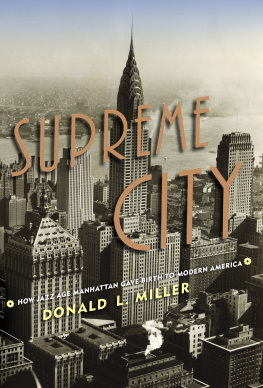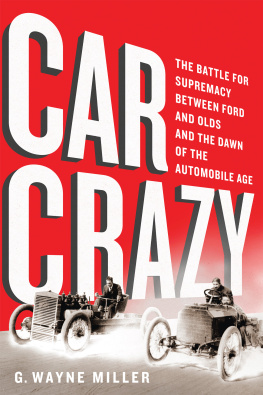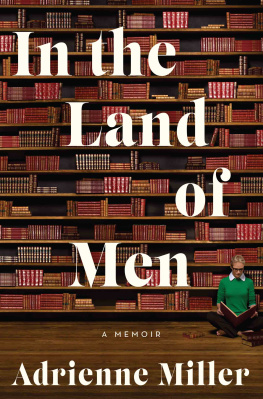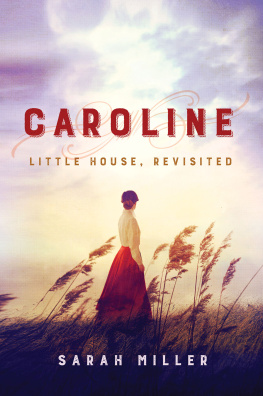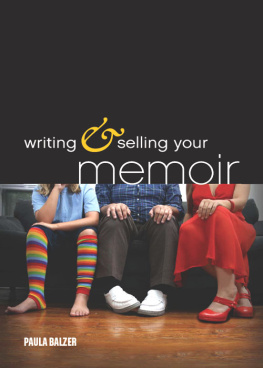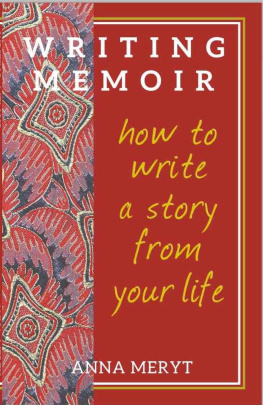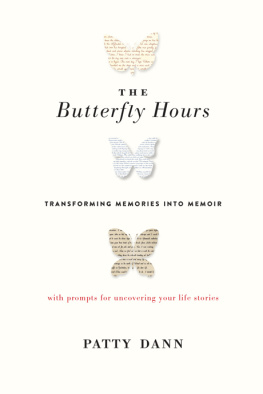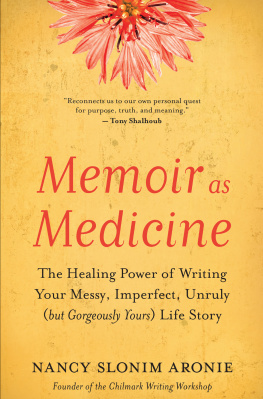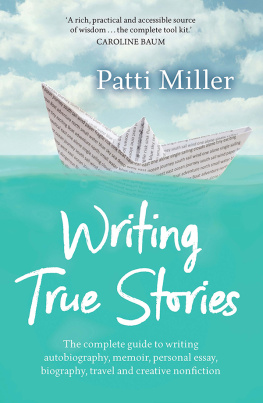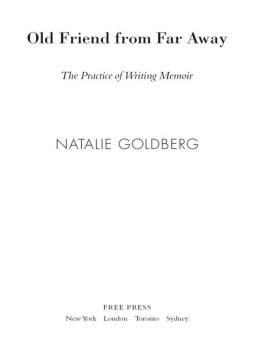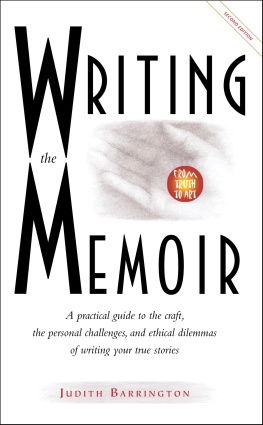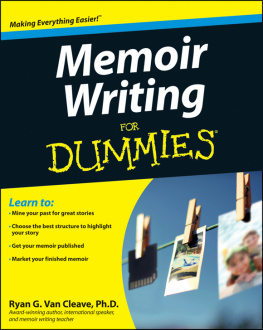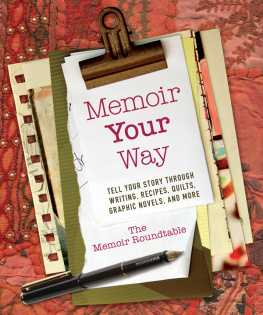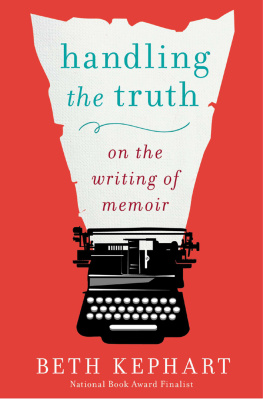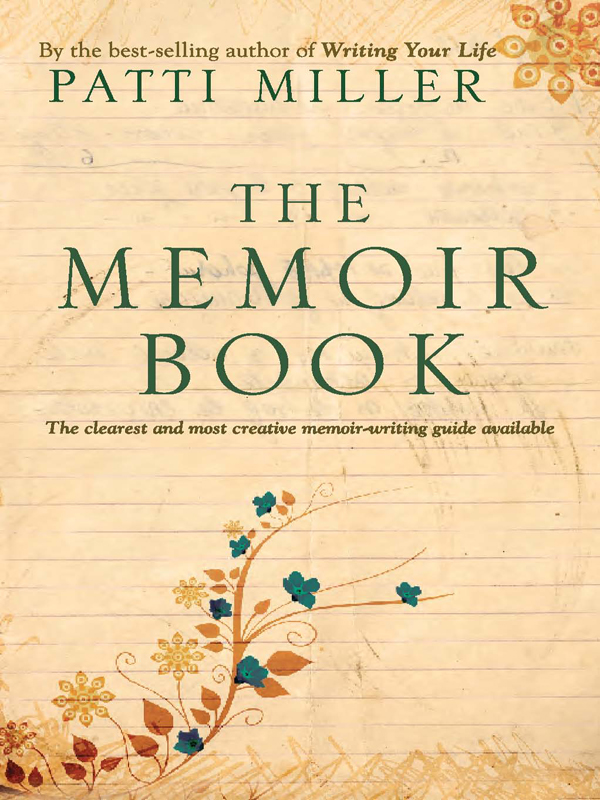
THE
MEMOIR
BOOK
Patti Miller opens the poetic door to the brain, the door of memory and free association, where your writing is much more likely to be vivid and glowing with the intensity of the original lived expeirence.
Sysan Wyndam, Sydney Morning Herald
THE
MEMOIR
BOOK
PATTI MILLER

First published in 2007
Copyright Patti Miller 2007, except extracts from other authors as listed in the acknowledgements
All rights reserved. No part of this book may be reproduced or transmitted in any form or by any means, electronic or mechanical, including photocopying, recording or by any information storage and retrieval system, without prior permission in writing from the publisher. The Australian Copyright Act 1968 (the Act) allows a maximum of one chapter or 10 per cent of this book, whichever is the greater, to be photocopied by any educational institution for its educational purposes provided that the educational institution (or body that administers it) has given a remuneration notice to Copyright Agency Limited (CAL) under the Act.
Allen & Unwin
83 Alexander Street
Crows Nest NSW 2065
Australia
Phone: (61 2) 8425 0100
Fax: (61 2) 9906 2218
Email: info@allenandunwin.com
Web: www.allenandunwin.com
National Library of Australia
Cataloguing-in-Publication entry:
Miller, Patti, 1954 .
The memoir book.
ISBN 978 1 74114 906 7.
1. AutobiographyAuthorship. I. Title.
808.06692
Typeset in 11.5/13.5pt Bembo by Asset Typesetting Pty Ltd
Printed in Australia by McPhersons Printing Group
10 9 8 7 6 5 4 3 2 1
To Anthony
CONTENTS
HOW WE EACH one of us live our lives, is still as fascinating to me as it has always been. Having worked with many hundreds of people on their life stories, the courage,humour, determination, passion and endless dazzling variety of individual lives continue to inspire and nourish my own life.
While The Memoir Book is an extension of my guide to autobiographical writing, Writing Your Life: A Journey of Discovery, it is also designed to be used independently.The MemoirBook focuses on memoir and the related genres of travel writing and the personal essay; it refreshes, develops and expands writing skills and issues introduced in Writing Your Life; and it explores concerns occurring further into the writing journey.
There are twelve chapters, arranged as a course, but you can dip in and use the writing exercises in any order you please. The chapters are based on live memoir-writing workshops and are informed by hundreds of manuscripts critiqued for other writers, as well as drawing on my own writing experience. Each chapter, except the first, includes writing exercises and extracts from published memoirs.
All writers, even the most experienced, at times need reminders of fundamental writing practices to help them head in the right direction. Or, perhaps, to find a new direction. I hope this book will do both. To me, the test of a useful writing book is whether you put it down and start writing so I hope you will read The Memoir Book, the whole lot or a chapter, then put it down and pick up your pen or sit at your computer, ready to write.
1 .
EXPLORING THE
TERRITORY
WHAT IS IT like for you to be here in the world? To me, that is one of the most interesting questions of all. It is the question I want to ask the tall Tahitian girl standing in the airport queue, the pallid man at the supermarket checkout, the grey-haired woman in the beribboned hat sitting on the beach, everyone I pass on the street.
What is it like for you to be in the world? What childhood dream, or perhaps dread, led you to this point in your life? What roads travelled, or less-travelled, have you taken? What do you believe about yourself? Do you feel most at home sitting by a fire in the country or dancing in a New York nightclub? Do you like rain on your face? How many sunrises have you seen? Do you have a compass and, if so, what is it made of?
What is it like for anyone to be in the world? This is the vast and private knowledge that each one of us has and the great mystery. No one else can really know what it is like for you to be here on this planet. Others could conceivably know everything that has happened to you, your entire history, but they still could not know how you experience being here. For me, this is the starting point for autobiographical writing and reading: a desire to express how one experiences the mystery and the journey of existing its shape, its texture, its atmosphere and a consuming curiosity to know how other people experience it.
Still, the desire to express ones experiences in writing is, by itself, not enough. Life is made of flesh and blood and tables and trees and office buildings;writing is made of words can one level of reality be transmuted into the other? Post-modernist thought suggests that words can never represent life; they can only represent a parallel world of words, a world of signs. Words are not a window through which we can see reality, they are more like permanent contact lenses that construct the world we see according to the colour and thickness of the lens. More than that, the lens also shapes our inner world. For example, our concept of the complex set of feelings and bodily responses we have in relation to another person is shaped by the words romantic love. The feelings themselves are to some extent formed and shaped by the words. It is almost impossible to imagine (because we use words to imagine too) how we could experience the world without language. Still, acknowledging our lens, accepting that words will always form our perceptions and conceptions of our experience,we can still try to set down what and how we see through and with them.
The demand for autobiographical writing reveals that many of us share the desire to know what life is like for others. And many of us share the desire to tell our own stories. The journey of writing in our case life writing, and more specifically memoir has its own paths and signposts and changing terrains to be explored.
Life writing? Autobiography? Memoir?
What is the difference between life writing and autobiography? Or autobiography and memoir? And what about memoirs add an s and is it something else again? Defining the territory could be useful before heading off on the journey.
There are many definitions, but lets agree that life writing means non-fiction writing on subjects of personal experience and observation; it includes autobiography, biography, memoir, memoirs, personal essay, and travel and sojourn writing.
Autobiography is generally agreed to be an account of a whole life from ones origins to the present. (For the most part Writing Your Life: A Journey of Discovery discussed how to write autobiography.) It can include some family history but concentrates on the individual life, exploring childhood experience, personal development, relationships, career in fact anything that the autobiographer wants to include.
Biography seems clearly enough an account of someone elses life, although it too can spread out at its edges to include elements of memoir. The biographer can become part of the story. For example, Poppy by Drusilla Modjeska started out being a biography of her mother but became as much a memoir and even, in places, fiction.
Memoir is an aspect of a life shaped by any number of parameters, including time, place, topic or theme. One can write a memoir of childhood, or of a year in Turkmenistan, or of a relationship with a parent. While autobiography moves in a dutiful line from birth to fame, omitting nothing significant, memoir assumes the life and ignores most of it (
Next page

